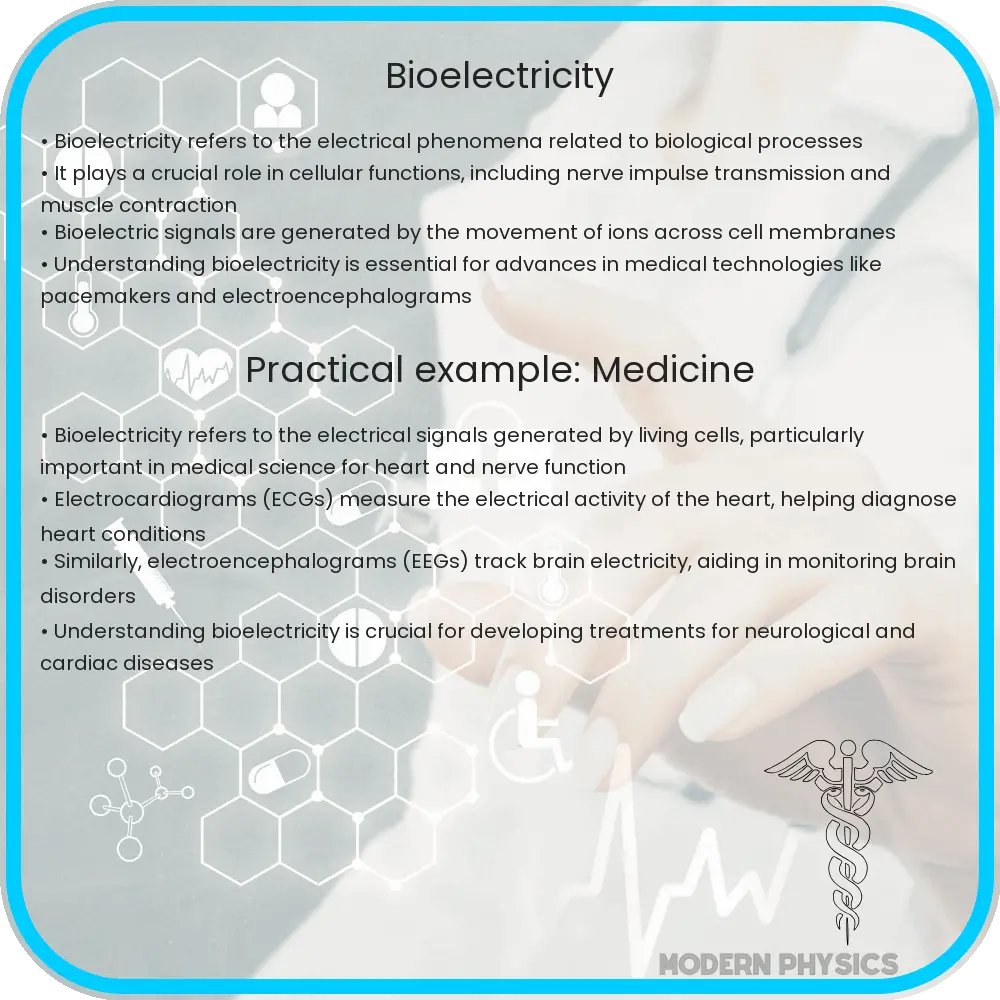Explore the fascinating world of bioelectricity in biophysics, uncovering its principles, applications in healthcare, and the future of medical technology and research.

Bioelectricity: A Keystone in Biophysics
Bioelectricity refers to the electrical phenomena related to biological processes. Integral to biophysics, it explores how cells and tissues generate and respond to electrical charges. Understanding bioelectricity is crucial for deciphering the complex communication networks that underpin life itself.
Principles of Bioelectricity
At the core of bioelectric phenomena are ions—charged particles such as sodium (Na+), potassium (K+), chloride (Cl–), and calcium (Ca2+). These ions traverse through channels in cell membranes, creating electrical gradients crucial for various physiological functions.
- Resting Potential: The resting potential is the electrical charge difference across the cell membrane in its resting state, primarily maintained by potassium ions.
- Action Potentials: Action potentials are rapid changes in the membrane potential that propagate along nerve and muscle cells, essential for transmitting signals.
- Electrochemical Gradient: This gradient combines the effects of the concentration gradient and the electric potential gradient, driving the selective movement of ions across membranes.
Applications of Bioelectricity
Bioelectricity has vast applications in medical diagnostics and treatments:
- Electrocardiography (ECG): Utilizes bioelectric signals generated by cardiac muscle contractions to monitor heart health.
- Electroencephalography (EEG): Records the electrical activity of the brain, aiding in the diagnosis of conditions like epilepsy.
- Electromyography (EMG): Measures the electrical activity produced by skeletal muscles, detecting neuromuscular abnormalities.
Ongoing Research in Bioelectricity
Current research in bioelectricity is not just limited to understanding these phenomena but also harnessing them for innovative medical therapies and technologies. Scientists are exploring how bioelectric signals in cells can be manipulated to regenerate tissues, treat chronic wounds, and even combat cancer. The field is rapidly evolving, with potential breakthroughs promising to revolutionize healthcare and our understanding of biological systems.
Emerging Technologies and Future Directions
As the field of bioelectricity continues to grow, researchers are developing groundbreaking technologies that leverage bioelectric principles. Bioelectronic medicine, for instance, targets specific nerves with electrical impulses to treat diseases without pharmaceuticals. Another area of intense study is the development of bioelectric sensors capable of detecting changes in the body’s electrical activity, offering new ways to monitor health and diagnose diseases early.
Challenges and Considerations
Despite its promise, the application of bioelectricity faces challenges. Understanding the complexities of bioelectric signals within the human body’s intricate systems requires more research. Additionally, there are ethical considerations in developing technologies that interact so closely with our biological processes, emphasizing the need for responsible innovation.
- Precision Medicine: Tailoring bioelectronic treatments to individual physiological differences promises more effective and personalized healthcare solutions.
- Regenerative Medicine: Research into bioelectricity’s role in cell proliferation and differentiation opens avenues for regenerating tissues and organs.
- Neuroprosthetics: Advances in bioelectricity could enhance the development of prosthetics that mimic the functionality of natural limbs more closely, improving quality of life for amputees.
Conclusion
The exploration of bioelectricity stands at the confluence of biology, physics, and technology, offering profound insights into life’s fundamental processes. From understanding how neurons communicate to developing cutting-edge medical devices, bioelectricity embodies a promising frontier in science and medicine. As we continue to unravel the mysteries of bioelectric phenomena, we edge closer to harnessing their full potential, heralding a new era of medical innovation and biotechnological advancements. The journey of bioelectricity, from basic science to transformative applications, illustrates the power of interdisciplinary research in paving the way for future discoveries that could reshape our world.
